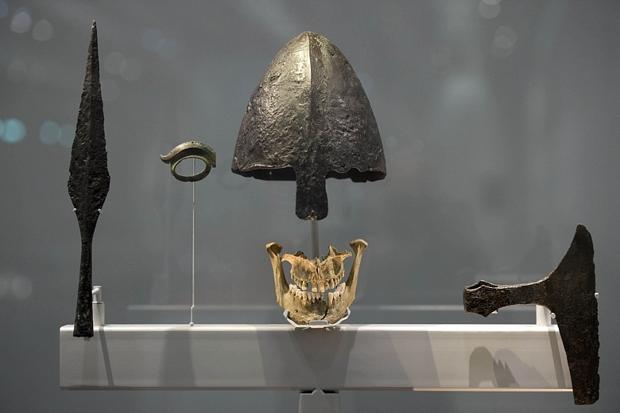Vikings in London
I spent this term studying a paper called "The Viking Age: War and Peace c.750-1100", a module covering Scandinavian raiders and settlers and their activities at home and abroad. It has conveniently coincided with Copenhagen's celebrated Viking World exhibition hitting my own home town. Professor Lesley Abrams, much celebrated in viking circles and coincidentally my tutor (Oxford education whaddup) was invited to the opening a fortnight ago, bringing its existence to our class's attention; she did not sing its praises. Neither did many other reviewers. Undeterred my mum and I spent a sunny Friday afternoon eating and wandering in central London, before charging into the British Museum and ploughing mercilessly through the foreign hoards (a la vikings) towards the declamatory banners of rusty-sword-overlaid-with-swirling-ocean (original). We got two steps into the first room and then turned around and left. The place was absolutely rammed. It was unbearable. I was aware that the popularity of the exhibition had meant tickets were sold in timed slots, but this was something else entirely - a queue that snaked around the entire exhibit creating a human conveyor belt of fleeting glimpses of glass-cased objects and universal impatience and despair. Seeing our despondency a security guard took us aside and recommended we return either first thing in the morning or last admission in the evening to have any chance of enjoyment, so we headed to the members lounge to drown our sorrows in tea and free wifi, and returned at 10am the next day to a slightly less horrifying scene.
I will admit to finding over-crowding in museums and galleries horrendous and experience-ruining, so I didn't even attempt to examine every object or read every sign. There were some specific artefacts that I really did want to see, and I zoned in on them right away - it was an absolute treat standing in front of the Lewis chessmen, relics of that time when the Western Isles belonged to Norway and not Scotland (ha), and seeing my personal favourite of a tiny 2x2cm silver sculpture of Odin and his seeing eye ravens Hugin and Munin. I enjoyed the re-construction of a viking longship, complete with real-life ship bits slotted into the metal frame, and I appreciated the garish replica of Harald Bluetooth's Jelling Stone - his monument to his own success as a uniter of Denmark and champion of Christianity. But I couldn't help but feel that I enjoyed all of this so much exactly because I understood these objects' significance within the viking "life" or "legend" as a whole; not to sound like the condescending history student that I am, but I feel that the joy of the artefact lies within what it can tell you and how it can be interpreted. There was a dearth of explanatory information, and it was not limited to unsatisfactory descriptions of objects. Perhaps it's just unrealistic expectations of curators to cram into three rooms what I have learnt in 8 weeks of a history degree, but if you're going to title an exhibit "Vikings: life and legend" then I feel you're implying you will do some explaining of life versus legend - or just some explaining in general.
I am being unfair and I know it. I totally learnt some new things and there were some really great curatorial touches - the snippets of skaldic verse printed on the walls, and eery recordings of Norse being spoken over the lapping of waves and creaking of oars (obviously). But I think that some of the more thrilling and "legendary" aspects of viking times were unnecessarily skipped over. The example I would choose is that of the Ridgeway Hill skeletons, displayed in an awkward corner. This was a mass viking grave found in Dorset in 2009, containing 54 dismembered skeletons of Scandinavian males (mostly) aged 16-25. They showed no evidence of being involved in a battle, but had certainly suffered a violent death - they had all been tossed naked into the pit, almost certainly executed, possibly as captives, at a time of conflict between native Anglo-Saxons and Scandinavian settlers. This is exactly the sort of mysterious and gory tale that makes popular history. Who were they? How did they die? Who killed them and decapitated them and buried them so dishonourably? Was there an audience? What happened to the missing heads? In the exhibit the only thing written about this intriguing discovery was that it "proved the vikings didn't always win"... a rather vague statement that I thought really wasted a real-life historical conundrum. But then again, I almost certainly ended up doing history for my morbid temperament alone, so perhaps these are not the questions that plague your average museum-goer.
And while I'm complaining about everything and anything I must say that much as I hate exhibitions being overly child orientated, the British Museum does love to encourage enormous numbers of primary school parties and under-12s and almost none of the exhibition was child-friendly or interactive. Far be it from me to encourage the presence of any children in any public space ever, but this lack of engaging things to plonk your 4-year-old in front of while you read up on the intricacies of longship construction led to several tantrums and over-active small people underfoot. I can't imagine that its Scandinavian incarnation was so lacking.
So to sum up: I'm glad that I went, I will almost certainly go again, but I do feel like more could have been done with this exhibit. For your average British Museum goer who has had to pay £15 for this claustrophobic experience and whose knowledge of the vikings is limited to drooling over Chris Hemsworth in the latest Avengers instalment, I'm not sure it really does the trick.


